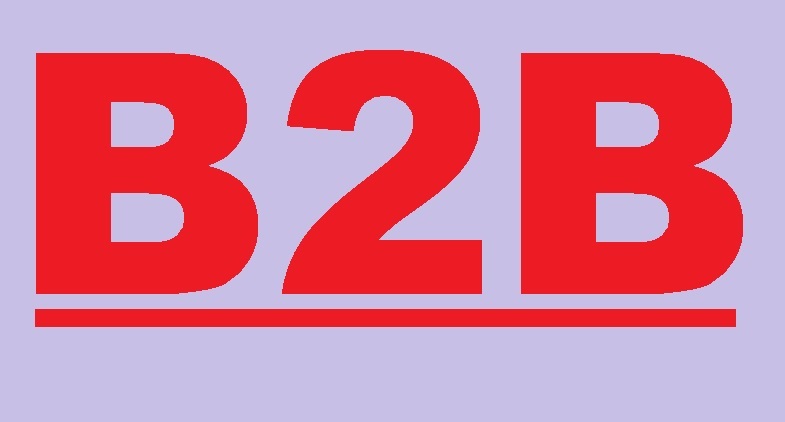Business to business

|
[edit] Introduction
Business to business (sometimes abbreviated B2B or BtoB) is a term that encompasses the range of transactions and services which can take place between a business and other businesses. These transactions can take place at one end of the scale when small businesses sell and buy products from each other, or at the other end, when large quantities of goods and services flow between big companies.
Typical examples include the activities taking place between manufacturers and wholesalers or wholesalers and retailers.
A retailer selling to a customer or end user is not included in B2B; it is in fact business to consumer (B2C). When there is a combination of business to business (B2B) and business to consumer (B2C), that transaction is referred to as B2B2C. This type of transaction typically takes place through e-commerce portals. Furthermore, when a business enters into transactions with government, it is called business to government (B2G).
[edit] The supply chain
A typical supply chain comprises a series of B2B transactions. A company buys products and/or services from other companies to help produce its final product, or to facilitate its business activities. As an example, a specialist machinery manufacturer sells glass-making equipment to a glass-making factory which in turn buys sand from a quarry and sells the finished glass to a DIY store. All of that chain is part of B2B. However, when the DIY store sells the glass to a consumer (or end user) it is part of a B2C transaction.
B2B methods encompass a wide range of activities, usually to make a profit for each of the businesses involved. These activities include sales and marketing, publishing, use of social media and the provision of other services.
Products used by businesses can be complex, or specially designed and typically involve significant development costs. Suppliers of these products tend to be highly skilled and become intricately involved with their customers’ businesses, in many cases catering for their specific requirements.
The players in a B2B chain may be concentrated in a specific geographical area for logistical and developmental reasons. For example, businesses may agglomerate around natural resource concentrations, e.g brickmakers located close to clay quarries. Another reason may be to be close to a pool of highly skilled workers, such as is the case at Cambridge Science Park in the UK, or Silicon Valley in the US. The latter features a cluster of software and hardware manufacturing industries, related mostly to computing, all realising the benefits associated with being in close proximity with each other. In this way, clusters of industries form in specific areas.
[edit] Related articles on Designing Buildings Wiki
- BS11000 Collaborative business relationships.
- Can relationships in and between organisations make tangible differences to business performance?
- Collaborative practices.
- Framework agreement.
- Government to support businesses through Trade Credit Insurance guarantee.
- Integrated project team.
- Integrated supply team.
- Leadership styles.
- Partnering.
- Supply chain management.
- Team behavioural roles.
- Team management.
Featured articles and news
The UK's Modern Industrial Strategy: A 10 year plan
Previous consultation criticism, current key elements and general support with some persisting reservations.
Building Safety Regulator reforms
New roles, new staff and a new fast track service pave the way for a single construction regulator.
Architectural Technologist CPDs and Communications
CIAT CPD… and how you can do it!
Cooling centres and cool spaces
Managing extreme heat in cities by directing the public to places for heat stress relief and water sources.
Winter gardens: A brief history and warm variations
Extending the season with glass in different forms and terms.
Restoring Great Yarmouth's Winter Gardens
Transforming one of the least sustainable constructions imaginable.
Construction Skills Mission Board launch sector drive
Newly formed government and industry collaboration set strategy for recruiting an additional 100,000 construction workers a year.
New Architects Code comes into effect in September 2025
ARB Architects Code of Conduct and Practice available with ongoing consultation regarding guidance.
Welsh Skills Body (Medr) launches ambitious plan
The new skills body brings together funding and regulation of tertiary education and research for the devolved nation.
Paul Gandy FCIOB announced as next CIOB President
Former Tilbury Douglas CEO takes helm.
UK Infrastructure: A 10 Year Strategy. In brief with reactions
With the National Infrastructure and Service Transformation Authority (NISTA).
Ebenezer Howard: inventor of the garden city. Book review.
The Grenfell Tower fire, eight years on
A time to pause and reflect as Dubai tower block fire reported just before anniversary.
Airtightness Topic Guide BSRIA TG 27/2025
Explaining the basics of airtightness, what it is, why it's important, when it's required and how it's carried out.
Construction contract awards hit lowest point of 2025
Plummeting for second consecutive month, intensifying concerns for housing and infrastructure goals.
Understanding Mental Health in the Built Environment 2025
Examining the state of mental health in construction, shedding light on levels of stress, anxiety and depression.





















